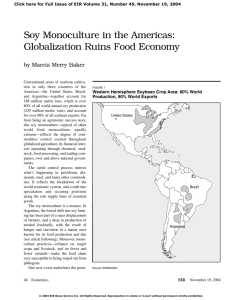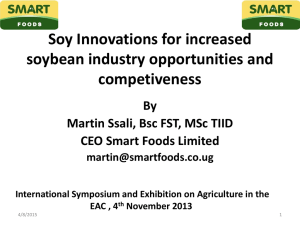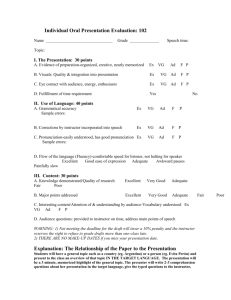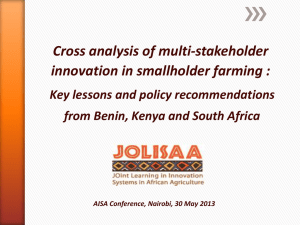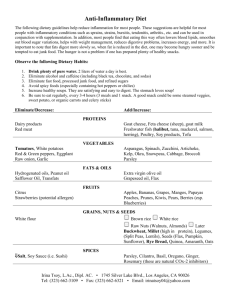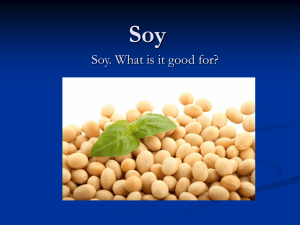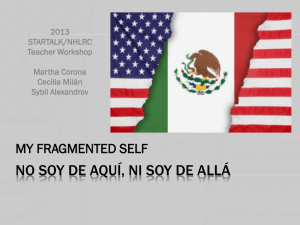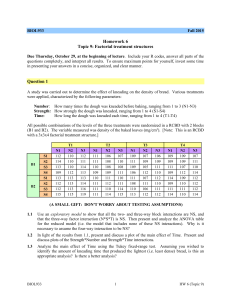Soy Monoculture in the Americas: Globalization Ruins Food Economy
advertisement
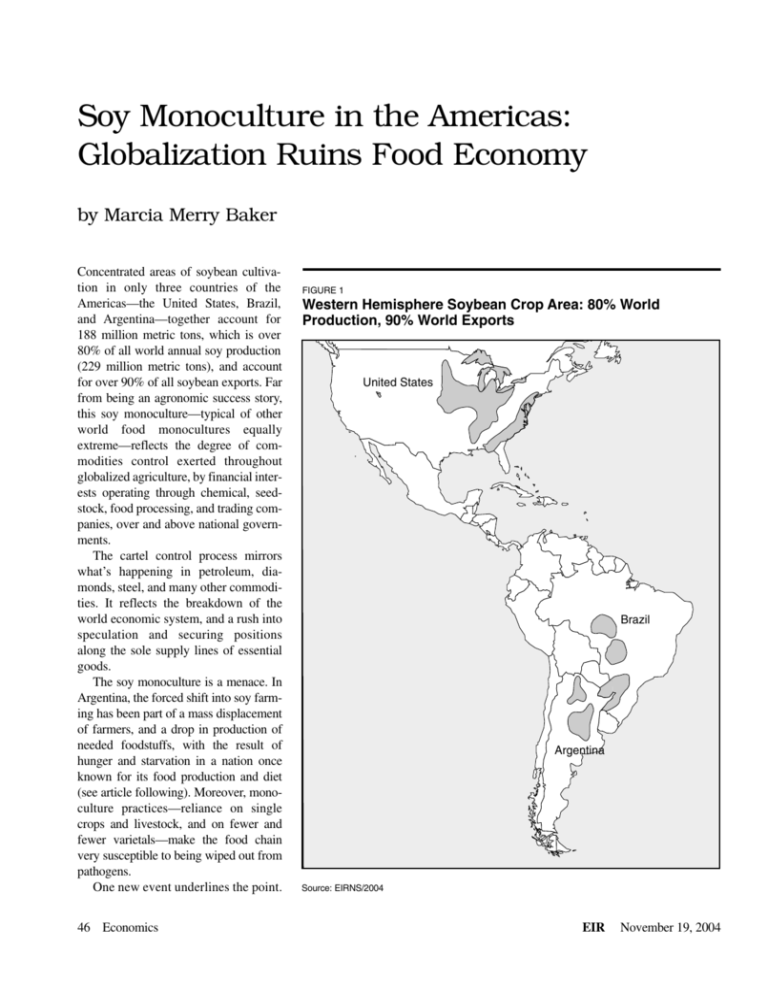
Soy Monoculture in the Americas: Globalization Ruins Food Economy by Marcia Merry Baker Concentrated areas of soybean cultivation in only three countries of the Americas—the United States, Brazil, and Argentina—together account for 188 million metric tons, which is over 80% of all world annual soy production (229 million metric tons), and account for over 90% of all soybean exports. Far from being an agronomic success story, this soy monoculture—typical of other world food monocultures equally extreme—reflects the degree of commodities control exerted throughout globalized agriculture, by financial interests operating through chemical, seedstock, food processing, and trading companies, over and above national governments. The cartel control process mirrors what’s happening in petroleum, diamonds, steel, and many other commodities. It reflects the breakdown of the world economic system, and a rush into speculation and securing positions along the sole supply lines of essential goods. The soy monoculture is a menace. In Argentina, the forced shift into soy farming has been part of a mass displacement of farmers, and a drop in production of needed foodstuffs, with the result of hunger and starvation in a nation once known for its food production and diet (see article following). Moreover, monoculture practices—reliance on single crops and livestock, and on fewer and fewer varietals—make the food chain very susceptible to being wiped out from pathogens. One new event underlines the point. 46 Economics FIGURE 1 Western Hemisphere Soybean Crop Area: 80% World Production, 90% World Exports United States Brazil Argentina Source: EIRNS/2004 EIR November 19, 2004 On Nov. 10, the U.S. Department of Agriculture confirmed that soybean rust has been found in the United States for the first time ever. The rust, a fungus of the species Phakopsora pachyrhizi, was identified in Louisiana. It can cut yields significantly. Since the 2004 U.S. crop is mostly harvested by now, the questions become: Will there be fungicide available next year? Can farmers afford it? The same fungus—entrenched in Asia—arrived in South America in 2001, and has spread since, reaching Argentina in A research plot of rows of soybeans. The plant’s origins go back over 3,000 years, to China; 2003. Its recent arrival in North now it is a mainstay for oils, plant protein, and livestock feed, for the various diets of billions of America is attributed to the winds of people. November is the end of soybean harvest in North America. this year’s exceptionally long hurricane season. FIGURE 2 Monoculture of livestock presents other dangers, of potenArgentina: Major Soybean Crop Area tially facilitating microbial “mixing bowls” for influenza, and other threats. BOLIVIA PA Soy Hyper-Regions EIR November 19, 2004 G UA Y nt C or rie Santiago del Estero Santa Fé Córdoba Entre San Ríos Luís es Salta C H IL E PA C I F I C O C E A N Figure 1 shows the major soy cropland regions in North and South America today, which evolved over decades in the United States; then more rapidly, over the past 25 years, in Brazil; and now most dramatically, in Argentina (Figure 2), under globalized food trade. In the United States, it wasn’t until the 1930s, that commercial soybean operations came into being, for food and livestock feed. The bean, considered to have originated over 3,000 years ago in Manchuria, was not part of European farm and food culture. As of 1900, barely a few thousand acres were cultivated in the United States. But by 1960, some 10.1 million hectares (25 million acres) were planted to soy; by 1970, it was 17.5 million hectares (43 million acres). This year’s U.S. planting was a record 30.4 million hectares (75 million acres), the highest in history. The harvest is expected to be 84 million metric tons, the largest ever, with a record high yield. Over 30% of production is concentrated in Iowa, Illinois, and southern Minnesota (Figure 3). Domestically, by the 1990s, 83% of U.S. margarine came from soy, and 80% of salad and cooking oils. This October, Monsanto and Cargill announced a partnership to get farmers to switch to their new patented “low-fat” soybean strain (requiring less hydrogenation in the final product); they intend to make a killing on the miracle bean in the near future. In Brazil, the 1970 soy crop, from which exports were going to Japan, was only 1.509 million metric tons; but by 1980, it had grown to 15.156 million metric tons; 19.898 million in 1990; and today, 52.6 million. The area cultivated RA Misiones B R A Z IL Buenos Aires La Pampa A R GE N TIN A ATLANTIC OCEAN Source: EIRNS/2004. Economics 47 soy hinterland of Argentina’s Mato Grosso state, to Cargill’s deep-water port at Santarem, on the Amazon United States: Major Soybean Crop Area River. The same point applies to the merits of the soybean itself. Other than for dietary preference, it is a diversion to debate the “pros” and “cons” of soy vs. meat protein. The fundamental point is that the commodities cartel is exerting dictatorial rights over national food supUnited States plies, and even over seedstocks—the means to life. During the 1990s, Monsanto won a patent, not merely for a new soybean strain, but for the procedure itself of genetic modification of soy! Its principal strain is “Roundup Ready,” referring to a bean that is impervious to the Roundup herbicide patented by Monsanto. The scientific debate is not on the Major Growing Areas pros and cons of genetic modification. Minor Growing Areas The evil lies in the actions of the cartel grouping—called synarchist as of 50 Source: NOAA/USDA. years ago—to arrogate decisions over seeds, plantings, and ultimately, over who eats, and who doesn’t. grew accordingly, including vast fields carved out of the Most of the U.S. soybean crop is now Roundup Ready. In Amazon ecosystem. In Argentina, the 1970 soy crop was Brazil, despite the fact that no Federal approval has been 27,000 metric tons, reaching 3.5 million in 1980; 10.667 milgiven, an estimated 30% of the crop in Rio Grande do Sul is lion in 1990; and today, in the range of 34 million. As shown Roundup Ready. Right next door, in Paraguay, on Oct. 20, the in Figure 2, soy has “invaded” the famed Pampas and other Agriculture Ministry approved four soybean varieties containregions. ing Monsanto’s Roundup Ready trait. ADM, Cargill Cartel It is deceptive to infer from the big U.S. soybean harvest A few names dominate the rise of the soybean in the this year, that Cargill, ADM, et al. remain committed to their Americas—Archer Daniels Midland (ADM), Cargill, North American source of supply. Not so. In fact, Cargill and CentralSoya, Bunge, Mitsubishi, and others. ADM, based in U.S.-based Smithfield, both giant meat processors, are setIllinois, and headed for 70 years by the Andreas family, is the ting up operations in Brazil for hog production and packing world’s largest soy processor, calling itself “Supermarket to houses, utilizing soybean feed for meat export. On Oct. 29, the World.” Its history is notorious for government swindling European Union approval was given to Cargill to acquire and thuggery. Michael Andreas, son of founder Dwayne Brazil’s Seara Alimentos SA. This furthers Cargill’s using Andreas, did jail time in the 1990s for price-fixing. Brazil as an export source for pork and chicken. Brazil’s These companies, not nations, currently run the world soyexports of poultry and pork soared by 53% this year, reaching bean trade. The largest importing nations are China and the 25$1.92 billion. member European Union, which together take over 60% of the At present, U.S. soybean prices to the farmer are barely $5 world’s soy exports, 90% of which comes from Brazil, a bushel, less than 10 years ago. Cargill is posting record profArgentina, and the United States. its, attributing this to lower soy costs. For the quarter ending Over 30 years ago, ADM, Cargill, Bunge et al. began to Sept. 30, Cargill’s profits were up by 77% from the same time reposition much of their soy exports base to Brazil and a year earlier ($266 million, or 41¿ per share, up from $150 Argentina. As this came about, the cartels demanded transmillion. portation improvements to serve their private interests. For And the U.S. Department of Agriculture reported on Nov. example, at present, Cargill is part of a consortium demand11 that by 2005, the United States is expected to become a net ing that a 1,071 kilometer Federal road be paved, from the food-importing nation for the first time. FIGURE 3 48 Economics EIR November 19, 2004 who went out of business between 1967 and 2001, 160,000 of them did so after 1990. Cartels’ Soy Revolution Kills Argentine Farming by Cynthia R. Rush In Argentina, the country known historically as the “granary of the world,” people generally didn’t die of hunger—at least up through the 1980s. While pockets of hunger and poverty could certainly be found in the country, people generally had access to a nutritious and varied diet, and food production was directed to the domestic market as well as for export. The fertile “pampas” were world famous, as was Argentina’s excellent quality beef. Yet between 1990 and 2003, as agronomist Alberto Lapolla reports, 450,000 Argentine citizens did die of hunger. In a June 2004 paper sent to EIR, Lapolla elaborated: Every day, 55 children, 35 adults and 15 elderly die from illnesses related to hunger. ‘Let 200,000 Agro Producers Disappear’ How did such a tragedy occur? The blame lies with the criminal financial predators behind the international food cartels—Cargill, Archer Daniels Midland, Bunge, etc.—that have systematically destroyed Argentina’s food-producing capabilities over recent decades, replacing them with large-scale production of geneticallymodified soy for export to a globalized market. The imposition of unbridled free trade, exemplified by Carlos Menem’s embrace of the International Monetary Fund’s policies during his 1989-1999 Presidency, has returned Argentina to “the colonial model of commodity export,” Lapolla writes. “We have ceased to be a nation.” Although the attempt to transform Argentina’s agricultural model began as early as the 1960s, it intensified dramatically after José Martínez de Hoz took over as Finance Minister of the 1976-83 military junta. A longtime servant of the City of London’s financial elites, Eton graduate “Joe” was known to complain that Argentina’s “huge internal consumption of food” was an obstacle to larger agricultural exports. Let the “market” decide everything, he argued—even if people starve. While quintupling the foreign debt, De Hoz spent his time in office dismantling state-run regulatory agencies that protected the nation’s productive apparatus. His legacy was then carried on by Menem’s Finance Minister, Wall Street errand boy Domingo Cavallo. Lapolla reports that one of Cavallo’s staff members demanded in 1990 that “at least 200,000 agro producers should disappear in Argentina because they are inefficient.” Cavallo did his job. Of the 260,000 family farmers EIR November 19, 2004 A Soy Republic? In an October 2004 document also made available to EIR, Argentina’s Rural Reflection Group (GRR) charges that this attempt to impose monoculture on the once-agriculturally diverse country has produced “an agriculture without farmers.” Government ministries and scientific agencies once assigned to deal with problems related to real production have been roped into this offensive, prodded by such well-financed Non-Governmental Organizations (NGOs) as the British Crown’s Worldwide Fund for Nature (WWF) and Greenpeace. Under the guise of protecting the environment, the WWF has supported the food cartels’ “Sustainable Soy” model, advocating expanded soy production only, while simultaneously demanding that large swaths of land be set aside as pristine ecology parks, protected from “contamination”—and agricultural production. Soy is now the country’s most important crop: it represented 50% of the country’s 2003 grain harvest of 70 million tons. Small family farmers can’t compete with larger producers who get credit and advanced technology to cultivate Monsanto’s “Roundup-Ready” strain of genetically-modified soy. In an article published in 2003, agronomist Walter Pengue reported that not only are the historically fertile “pampas” now dedicated in large part to genetically-modified soy production, but soy production has also expanded into the northwest, northeast and western parts of the country. While rice, corn, wheat, and sunflower production declined in significant percentages between the 1996-1997 and 2001-2002 harvests, soy production increased by 75%. Deforestation of regions cleared for soy cultivation has had disastrous ecological and economic results, including flooding and desertification. In a nation where 50% of the population still lives in poverty, the soy offensive has had a criminal impact on diet and health. At the beginning of 2003, per-capita beef consumption had fallen to 51 kilograms annually (about 110 pounds) compared to 61.4 kilograms in March of 2002—a decline of 10 kilograms per person, or 16%, in one year! Lands traditionally used for cattle grazing have declined, to give way to soy production for export. The IMF policy imposed on the country since the mid1970s had already forced changes in food consumption patterns, especially among the poor, by the mid-1980s. Highquality animal protein, fruits, vegetables, and dairy were increasingly replaced by pasta and bread, although the former were nonetheless still present in the diet. But today’s soy “revolution” has brought intense efforts— such as the “Soy Solidarity” campaign financed by such foreign multinationals as Monsanto—to replace animal protein with a diet based almost exclusively on soy. Despite unknown health consequences of such a diet, especially for very young children, soy products are increasingly the staples offered at soup kitchens for the poor around the country. Economics 49
